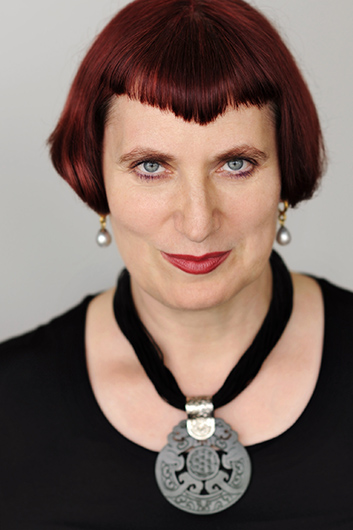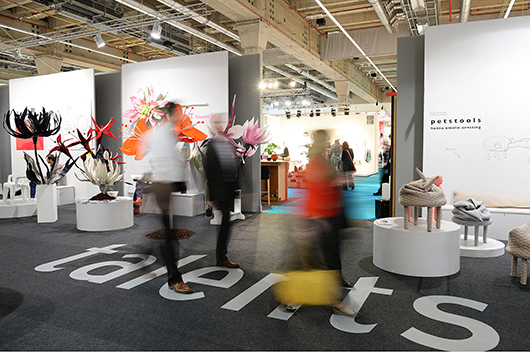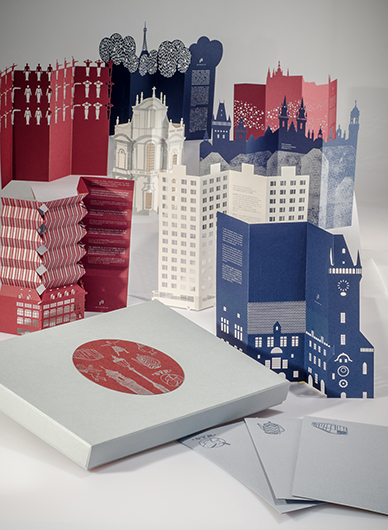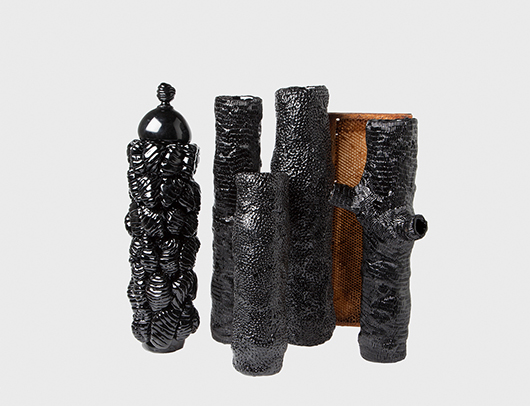Ambiente Talents 2015: 34 young designers from all over the world have surprises in store with some unusual projects

From 13 to 17 February 2015, this year's Talents programme is just as international as Ambiente itself: 34 participants from 15 countries will present their ideas, designs and finished products to the trade-fair public: the Talents show is more international than ever before.
 title="Más..." />
title="Más..." />
The selected university graduates, young designers and design studios have been given one of the much sought-after stands in the Talents area. To enable good ideas to be transformed into successful products, Messe Frankfurt has been helping young designers along the road to a successful career with its Talents format ever since 2001. Each of the promising Talents receives their own stand, including infrastructure, free of charge and can in this way present themselves to thousands of international visitors and make new contacts.
Appearing in the spotlight of the fair is a significant step for young designers keen to transform their creative powers into a livelihood. The forum thus provided by the fair generates important contacts to potential customers and producers; young creative talents have the opportunity to receive professional, direct feedback about their designs. Not only this, however, but the exchange of ideas among young designers themselves leads to a valuable gain in knowledge: what kind of interests and emphases do the other participants have, how do they present themselves and what kind of success does it bring them?
The two Talents areas are located in Hall 4.0 (Table Contemporary Design) and in Hall 11.0 (Loft). Nicolette Naumann, Vice President Ambiente/Tendence, is convinced by the concept behind the promotional programme: “With us, Talents is located directly in the design-oriented premium environment of the respective product segment. This will enable young designers to accept orders directly on the one hand, and to find producers for their designs on the other. From our follow-up survey, we know that it actually works for approximately one half of the Talents. This is a fantastic success rate.”
Creative power and potential
The selection of the Ambiente Talents 2015 is an international cross-section taken of the world of creative young people. Thanks to a mixture of curiosity and endurance, their projects achieve unseen and surprising results that enrich the world of beautiful and useful things. In 2015, many visitors to the fair will once again make use of the opportunity to enter directly into an inspiring dialogue with the creators. Nicolette Naumann puts it in a nutshell: “I see our commitment as an investment in the future, from which our entire industry will profit.” In this way, the works of the Talents also offer purchasers and manufacturers the opportunity to integrate new ideas and products into their portfolio. The young designers are still not consistently profit-oriented and it is this lack of a profit motive that leaves them a great deal of freedom to experiment, together with new approaches, which can then be optimised in the form of cooperation. The manufacturers can certainly appreciate this - for many a visit to the Talents has meanwhile become an essential part of their agenda.
New directions in ceramics
A material which is naturally receiving particular attention with the Talents in the Dining segment is ceramics. This is in effect an invitation to young designers to experiment, as, unlike other product segments, they still have a hand in the manufacture. It is not surprising, therefore, that the results are produced in small series or even singly by the designer himself. The material is rolled, bent, folded and combined freely with other materials. The fragile artefacts have liberated themselves from all conventions and have nothing more at all to do with Grandma's coffee service.
The Hamburg Moij Design studio, for example, plays directly with the traditional past and applies the traditional blue onion pattern, not centrally onto a plate, but distributes it over three bowls of varying sizes. The complete pattern only becomes visible when these three ‘onion bowls’ are assembled. A further ceramics project by the two designers Stine Paeper and Angelina Erhorn is ‘origami crockery’ - origami inspired bowls and plates that are equipped with a large number of folds. To do this, unfolded paper models were carefully encased with plaster and thus provided the shape for the finished porcelain product.

Paper Universe
Folded bowls are a theme that also occupies the South Korean designer Kim HyunJoo. Her material is the traditional Korean HanJi paper. From this material, which is famous for its durability, Kim HyunJoo formed the ‘Fallen Leaf Tray’ series of bowls, modelled on various leaves. The series consists of two layers of paper separated by a wire mesh, which provides the leaf structure. The flat objects, which are coloured white, green or dark brown, can be shaped into individual forms by hand, thus transforming them into aesthetically appealing, useful everyday objects. The dark brown specimens with their coating of Korean ottchil lacquer are even water-resistant. With her fine plant-inspired design, the designer would like to imbue everyday products with nature's tranquillity.

The Czech-Japanese studio Porigami also works with paper. The owner, Tereza Hradilkova, is actually an architect, but now designs filigree buildings to a much smaller scale: she has specialized in pop-up cards, where, with subtle cuts and recesses, three-dimensional objects are created from the flat paper. The elaborate works of art are firstly lasered and then put together by hand. What gave rise to this passion was a stay in Tokyo, where Hradilkova joined up with Kumi Kobayashi, the Japanese creative partner, to develop a series of cards about Tokyo's buildings. The young company has already created cards bearing motifs from Japan, Hong Kong and the Czech Republic, as well as carrying out a great deal of commission work.

Visible reflections
As young representatives of the USA, the country partnering this year's Ambiente, Joseph Guerra and Sina Sohrab will be presenting their designs. The two got to know one another while studying furniture design at the Rhode Island School of Design and together have been the “Studio Visibility“ for almost three years. In keeping with the name, the two young creative designers have taken up the theme of mirrors, which, however, are not made of glass, but of stainless steel polished to a high gloss. The ‘Arc Mirror’ is a wall mirror which is equipped at the same time with a small border and a hole for hanging up objects. What is fascinating about this object is that it is made completely out of one piece, thanks to the stainless steel material. Its counterpart, the ‘utility mirror’ is a sturdy hand mirror that has been partly immersed in rubber to give it a colourful grip - a method the two designers have borrowed from tool manufacturing.

Creeping and humming
In her project ‘From Insects’, French designer Marlene Huissoud chose exclusive natural materials for her objects: propolis, a natural high-strength resin made by bees, and the cocoons of the silkworm. The propolis she uses is collected from rubber trees by the bees and is consequently deep black in colour. Huissoud has used this rare material to design a collection of containers made with methods taken from glass manufacture. The result is a set of mysterious, shiny block objects, whose shape and handcrafted surface structure hint at their plant origins. “I come from a family of beekeepers; the bees I regard as partners in the design process. I am attempting to find out how we can transform their natural waste into valuable handcrafted artefacts,” is how the London-based designer explains her interest. Huissoud combined the silk cocoons with diluted propolis to develop a material she calls ‘wooden leather’ and used them for a variety of interior objects.

Deliciously sustainable
Especially when it comes to storing and preparing food, the Talents have given thought to how existing concepts can be translated into tomorrow's sustainable concepts. In the project ‘Save Food from the Fridge’, the Jihyun David design studio takes the familiar tried-and-tested methods of food conservation and gives them a new, fresh form for the kitchens of today. Vegetables remain fresh longer through the evaporation of water, carrots and spring onions are stored vertically in damp sand, potatoes in a dark box. All elements are designed to be fixed to the wall and decorate the kitchen at the same time.

For mobile, pollutant-free preparation of food, the American designer Bodin Hon, who is based in Milan, has developed an advanced version of the solar stove with his ‘Solari’. Through slow cooking with solar energy, the dishes are prepared very gently and the cooker's large multifunctional bracket serves as a carrying handle or stand. One clever device that Hon has installed is a temperature sensor that makes it possible to read the inside temperature from the outside. Not only this: it is also sent straight to the smartphone via Bluetooth, where the Solari-App monitors the cooking process. At the same time the user can find out how many hours of sunshine are still available or the kind of delicious recipes other Solari users recommend.

Source: Ambiente
Read more news related Ambiente published at Infurma
Visit the Ambiente website
News Infurma:
Online Magazine of the International Habitat Portal. Design, Contract, Interior Design, Furniture, Lighting and Decoration
